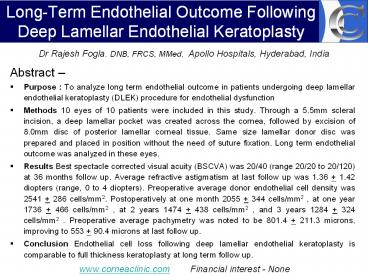Abstract PowerPoint PPT Presentation
Title: Abstract
1
Long-Term Endothelial Outcome Following Deep
Lamellar Endothelial Keratoplasty
Dr Rajesh Fogla. DNB, FRCS, MMed. Apollo
Hospitals, Hyderabad, India
- Abstract
- Purpose To analyze long term endothelial
outcome in patients undergoing deep lamellar
endothelial keratoplasty (DLEK) procedure for
endothelial dysfunction - Methods 10 eyes of 10 patients were included in
this study. Through a 5.5mm scleral incision, a
deep lamellar pocket was created across the
cornea, followed by excision of 8.0mm disc of
posterior lamellar corneal tissue. Same size
lamellar donor disc was prepared and placed in
position without the need of suture fixation.
Long term endothelial outcome was analyzed in
these eyes. - Results Best spectacle corrected visual acuity
(BSCVA) was 20/40 (range 20/20 to 20/120) at 36
months follow up. Average refractive astigmatism
at last follow up was 1.36 1.42 diopters
(range, 0 to 4 diopters). Preoperative average
donor endothelial cell density was 2541 286
cells/mm2. Postoperatively at one month 2055
344 cells/mm2 , at one year 1736 466 cells/mm2
, at 2 years 1474 438 cells/mm2 , and 3 years
1284 324 cells/mm2 . Preoperative average
pachymetry was noted to be 801.4 211.3 microns,
improving to 553 90.4 microns at last follow
up. - Conclusion Endothelial cell loss following deep
lamellar endothelial keratoplasty is comparable
to full thickness keratoplasty at long term
follow up.
www.corneaclinic.com Financial interest -
None
2
Introduction
- Endothelial keratoplasty A new method of
lamellar corneal surgery which allows selective
replacement of dysfunctional endothelium. - Various surgical techniques have evolved in the
past decade.1 - Encouraging results, namely early visual
recovery, and minimal refractive change in
corneal parameters have led to worldwide
acceptance of this corneal surgery. - Endothelial keratoplasty involves greater
manipulation of the donor tissue when compared to
full thickness corneal grafts. Various degrees of
endothelial cell loss following Endothelial
Keratoplasty have been reported in literature 2-5 - This poster presents long term endothelial
outcome in our initial patients who underwent
small incision DLEK procedure.
3
Materials and Methods
- 10 eyes of 10 patients, Male Female (4 6)
- Mean age 59.3 9 years (Range 44 to 78 years)
- Indications for DLEK surgery
- Pseudophakic bullous keratopathy 7 eyes
- Fuchs endothelial dystrophy 3 eyes (combined
with phacoemulsification with foldable
intraocular lens implantation surgery via a
superior scleral incision) - Surgical technique as described by Terry et
al.2,3(5.5mm scleral incision, deep lamellar
pocket created across the cornea, followed by
excision of 8.0mm disc of posterior lamellar
corneal tissue. Same size lamellar donor disc
prepared and placed in position without the need
of suture fixation)
4
(No Transcript)
5
Results
- Post-op average BSCVA 20/40 (Range,20/20
20/120) at last follow up, compared to preop
average BSCVA of 20/200 (Range, 20/40 hand
movements,HM) - Average Astigmatism 1.36 1.42 (Range, 0 - 4
diopters) at last follow up - Average Keratometry readings
- Operated eye 43.64 1.09
diopters ( 42.47 45.32), - Unoperated fellow eye 43.96 1.39 diopters
(41.9 46) - Pachymetry readings average preop 801.4 211.3
microns improving to 553 90.4 microns at last
follow up.
6
Endothelial changes - small incision DLEK
procedure
7
3rd Year follow up post small incision DLEK
Case 6
8
Endothelial changes following small incision DLEK
procedure
Eyes 1 month 12 months 24 months 36 months
Melles GJ 4 Am J Ophthalmol (2004) 15 NA 1859 477 1385 451 1047 425
Terry MA 5 Ophthalmology (2007) (Large small incision DLEK) 100 NA 2090 448 (26) 1794 588 (37)
Terry MA 5 Ophthalmology (2007) (Small Incision DLEK) 62 2020 (28) 1622 (43)
Fogla 10 2055 344 (19.1 loss) 1736 466 (31.6) 1474 438 (42) 1284 324 (50.5)
Post PK endothelial cell loss approximately
overall loss of 33 at one year, 52 by 3rd year,
and 59 by 5th year. Bourne et al.6-8 Cornea
2001 (560 569), Ophthalmology 1998 (1885
1865), Am J Ophthalmol 1994 (185 196)
9
Conclusions
- Small incision DLEK surgery resulted in good
visual recovery with minimal induced astigmatism
due to absence of surface incisions and sutures - Mean endothelial cell loss of 19 is seen
immediately post surgery and can be attributed to
intra-op surgical trauma to the donor tissue - Endothelial cell loss at one year is
approximately 31 ie further 12 loss from
immediate postoperative values - Endothelial cell loss continues at an approximate
rate of 10 per eye at 2nd and 3rd year follow up
in our study - Endothelial changes over three year period
following small incision DLEK is similar to
changes observed following full thickness
penetrating keratoplasty
10
References
- Goins KM. Surgical alternative to penetrating
keratoplasty Endothelial Keratoplasty. Int
Ophthalmol Sep 2007 - Terry MA, Ousley PJ. Small incision Deep Lamellar
Endothelial Keratoplasty (DLEK) 6 months results
in first prospective clinical study. Cornea 2005
24 59 - 65 - Fogla R. Initial results of small incision DLEK.
Am J Ophthalmol, 2006141346-351. - Melles G et al. Endothelial cell density after
posterior lamellar keratoplasty (Melles
techniques) 3 years follow-up. Am J Ophthalmol.
2004138211-7. - Terry MA et al. A prospective study of
endothelial cell loss during the 2 years after
deep lamellar endothelial keratoplasty.
Ophthalmology. 2007114631-9 - Bourne WM et al. Corneal endothelium five years
after transplantation. Am J Ophthalmol. 1994
118185-96 - Bourne WM et al. Cellular changes in transplanted
human corneas. Cornea 200120560-9 - Bourne WM et al. Ten-year postoperative results
of penetrating keratoplasty. Ophthalmology. 1998
Oct1051855-65

